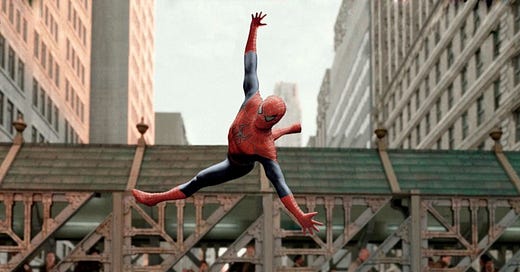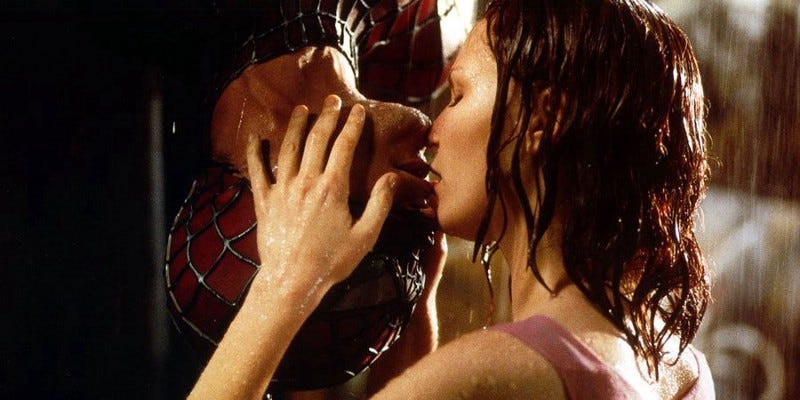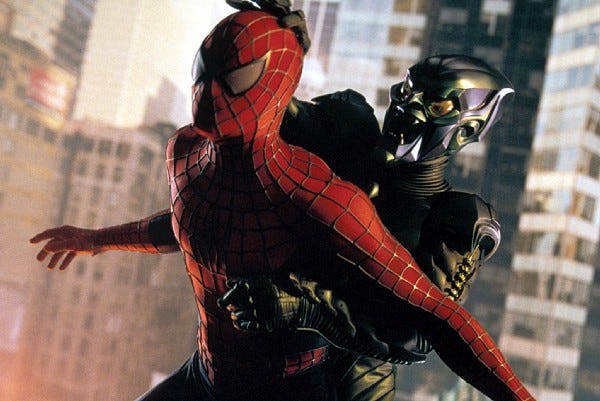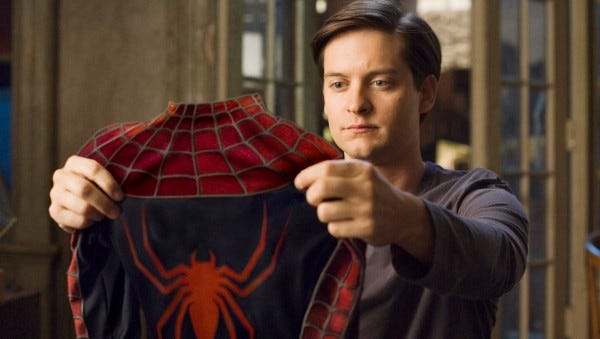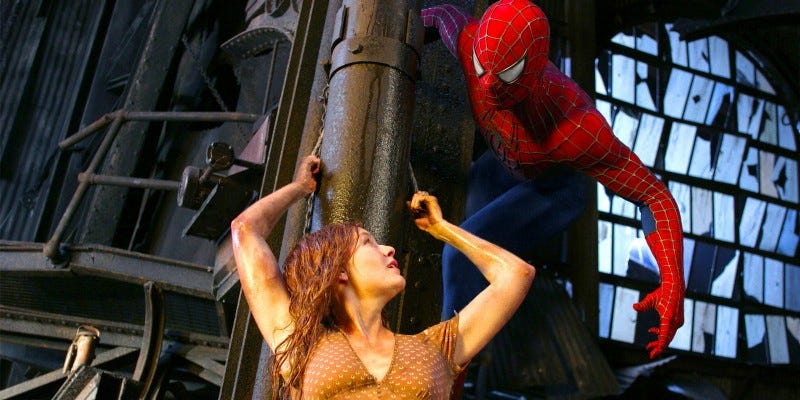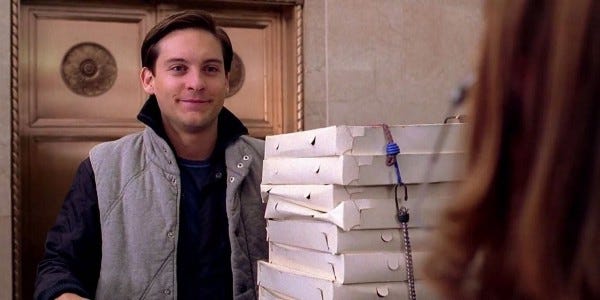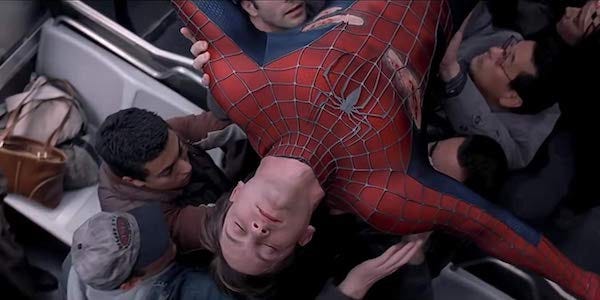Rerun: Spider-Man 2 Is the Best Comic Book Movie of All Time
Despite the latest animated competition, Raimi's sequel still stands above the rest.
I was seven years old when Sam Raimi’s Spider-Man 2 came out.
It was one of the greatest things to ever happen to me.
It was the first movie I ever saw multiple times in the theater. My parents were separated and I remember seeing it with one side of the family one weekend and the other side another weekend. That opening weekend was the first time in my life I had been in a sold-out screening (this has only happened a handful of times since) and I remember so well the energy in that auditorium.
I was a massive Spider-Man kid. I was the perfect age for it. He was on tv all the time: Spider-Man, Spider-Man and His Amazing Friends, and Spider-Man: The Animated Series all ran in syndication. I had one set of toys at one house that included Spider-Man walkie talkies and many action figures of Spidey’s enemies (my favorite being Kraven the Hunter) and another set at another house that included every piece you would need to reenact the climax of the first film, including a trigger toy that would make Goblin spin on his glider. The first comic I ever bought was Spider-Man (Marvel Knights: Spider-Man Vol 1, #12 — to be exact). I played a few different Spider-Man games on the PS2. I’m pretty sure I had Spider-Man light-up shoes (Mom, I’ll need you to fact-check this one.)
I could go on and on. You get the point, I was a big Spider-Man kid.
The release of Spider-Man 2 was a very big deal in my life.
I was captivated by the first movie. Who wasn’t?
There is a sincerity to the movies of the early millennia that perfectly matches the sincerity of traditionally child-aimed mediums the likes of comics or cartoons. And 2002 was jam-packed with those movies: the first Harry Potter entry, the live-action Scooby-Doo, and of course, Sam Raimi’s first Spider-Man.
All of those movies work so well for one main reason: They give overly-fictional concepts a genuine quality. They play everything seriously, but with an understanding that what they are doing is ridiculous. Spider-Man rides that line perfectly.
Compare it to the two camps of modern superhero films. First, the Chris Nolan and Zack Snyder: the overly serious. The dark. The gritty. Comics? They are silly and to be taken seriously in the modern-day they must be more Greek Tragedy than Garfield.
And then there’s the Kevin Feige perspective: Supers can be real world, but don’t forget it needs to be funny! Jokes jokes jokes! You know what’s funny — superheroes mentioning IKEA! There’s no such thing as manufactured comedy!
Spider-Man knows exactly how to bring a comic book from page to screen. It’s not the superhero movies we know today, it’s a comic book movie. The casting is perfectly cliched: Maguire the nerd, Dafoe the maniac, Dunst the girl next door, Franco the rich kid — everyone plays to their type. Raimi brings the iconography of a comic’s panels to his direction, finding still-moments in the action that feel just like a singular panel on a page. (The upside-down kiss comes to mind — actually, that entire sequence feels ripped from the pages.) The costumes are ridiculous (Green Goblin, anyone?) and the CG has aged like milk, but it all adds to the cartoon-like feel of illustrations.
It’s all over-the-top, but that commitment makes it feel so real. Marvel Comics grew in popularity because people found them more authentic than their counterparts. The characters are bold, the situations are larger than life, the colors poppy — but there was an authenticity to the world. After saving people from burning buildings or fighting giant lizards, Peter still had to stop at the store and buy bread or worry about how he was going to make rent. They found the mean of both sides.
Spider-Man finds that in both the story and the storytelling. It really is an ideal comic book film.
Needless to say, the stakes were high when it came to the sequel. I was ready to be wowed. And boy, was I!
Spider-Man 2 rides on the success of the original in the best possible way, so that they don’t have to waste any time with origin stories. Sure, they have to spend a little time setting up Doc Ock, but after watching Norman Osbourne be corrupted by the limits of his inventions in the previous film, we feel as though we understand Doc’s struggles immediately.
Since they don’t have to waste any time, they are able to spend their speedy two hours doing just about everything you don’t expect from a superhero movie.
Let me explain.
First, you must remember that this was 2004. Big-budget superhero flicks to this point had been, with varying levels of success, pretty cut and dry. Origin story, then bad guy, bad guy, bad guy until creatives felt bored and audiences wore thin, see: Superman IV: The Quest for Peace and Batman and Robin.
But Sam Raimi isn’t that type of filmmaker. He and his team of trusted collaborators did basically the opposite of everything we as the audience expected.
For starters, Peter Parker isn’t even Spider-Man for a majority of the movie. Instead, he’s doing laundry, reading poetry, and going to see The Importance of Being Earnest.
Can you imagine Chris Nolan having the balls?
Raimi, a big fan of the comics, took a hint from Stan Lee and the gang: focus more on the person and less on the hero — the reader (or in this case, the audience) will care more. It’s that simple. If you’re like me and you’ve never given a second thought to the MCU Thor, you know why.
And real people have real problems. At the end of the first film, we are led to believe that Peter and Mary Jane are on a road to happily ever after. Instead, they spend the whole movie doing a will they/won’t they that leads to Peter having his most tender moment in the whole film with Ursula, his crummy landlord’s daughter.
Could you imagine an MCU scene that has our main character find a sincere, heartfelt connection with his landlord’s daughter? No, you simply cannot imagine that.
Let’s try another one: the opening scene. We’ve been waiting two years to see Spidey swing on the big screen again. In the opening minutes, perhaps we catch him mid-battle with a more minor villain or caught in the midst of a criminal underworld?
Nope. He’s trying to deliver a pizza.
Because he delivers pizza to pay rent. Because he has to pay rent. Because he’s not rich like Bruce Wayne or Tony Stark. So he delivers pizza. On his nerdy moped. And he’s really bad at it because he’s a real person.
Well, the beginning of the film is subversive, and the main conflicts of the movie are more internal than external, so at least the ending has a huge blowout finale of a climax?
You know better at this point — of course not! He disarms Doctor Octopus, a villain on the verge of destroying the entire planet, by talking to him. He convinces him that it’s a bad idea…and then he doesn’t do it anymore.
And what a villain he is! As I said before, I must admit that he is a slight rehash of the Green Goblin, but I’m alright with that because that villain archetype is the most interesting of any. Forget the evils who want world domination for world domination’s sake (see: Zack Snyder’s Justice League¹), the most interesting bad guys are the ones who feel as though they have nothing to lose because they’ve already lost everything. In Doc Ock’s case, his breakthrough experiment (the one where he was eyeing the Nobel Prize) has failed spectacularly — killing his beloved wife and killing his reputation. He has nothing now except for the robotic tentacles bound to his spine.
So barrel-chested, half-naked Alfred Molina (not only would Disney never cast Rahad Jackson as a primary villain again, they would never let a guy of his build run around naked. Hell, they made Kumail Nanjiani swell up for Eternals!) runs around New York City with a true vengeance. We believe him and to a certain degree, we empathize. No, actually, we do empathize. And Peter does too. That’s how he’s able to talk him down from doing what he knows is wrong.
I could go on and on — and I haven’t even mentioned the unbelievable train sequence yet. The climax before the climax. I had a toy subway train as a boy and re-enacted this scene a million times. Because’s it’s awesome. I could never write anything that would do justice to the magnitude and power of that scene. If you’ve seen it recently, you know what I’m talking about — if you haven’t, what are you doing reading this!
But I feel as though the moment after Peter has saved the train is really the perfect scene to encapsulate the whole movie. Yes, we have flashbacks to “With great power comes great responsibility” and we have Aunt May’s “There’s a hero in all of us,” but I think that the moment after Peter has been fully exhausted by the strength it took him to stop this barreling train is the most powerful moment in the film.
Peter has lost his mask in the fight and when he passes out from complete exhaustion, his face is revealed to everyone on the train (Remember, this is Peter’s worst nightmare: he has distanced himself from Mary Jane for this exact reason — if his enemies know who he is, they will know her as well). But every person on that train agrees, without saying a word to each other, that they will never speak a word of this to anyone else. They are so desperate for a hero after Spider-Man has been missing for so long, they would never do anything to jeopardize that. His mask is returned by two boys in complete awe (“We won’t tell nobody”), but at that moment Doc Ock climbs aboard the train.
Here’s where I get weepy.
The passengers know he’s too weak to fight. Their hero cannot save the day this time. So they step up — both literally and in a powerful metaphor. Joey Diaz steps forward, “You want to get to him, you gotta go through me.”
“And me.”
“And me.”
They have found their inner hero. This post 9/11 New York City (I had to!) has learned that heroes come in all shapes and sizes, from your next-door neighbor to the person sitting next to you on the train. And when you need to step, you step up.
Aunt May said it best, “There’s a hero in all of us.”
Little me loved this movie and adult me can’t believe how well it holds up. By subverting everything we’ve seen over the past 45 years in superhero cinema, it stands atop the genre.
I’m seeing Spider-Man: No Way Home tonight and although I’m aiming low after the previous MCU entries, I’m excited to watch the Spider-Man that taught me what it means to be a hero, love your neighbor, and respect others, on the big screen again.
(If he’s in it.)
(He is.)
(Right?)
¹I’ve dedicated an uncharacteristic amount of space in this article to poo-ing on many films, which is not something I like to do. I want to celebrate cinema (and there are movies like Zack Snyder’s Justice League and Nolan’s Dark Knight trilogy that I really do like), but I’m using these examples to show that although these films check many of the aforementioned boxes, nothing checks them all off like Spider-Man 2.
Photos: Sony Pictures

